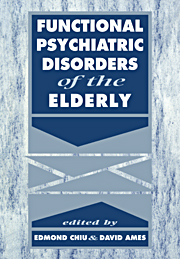Book contents
- Frontmatter
- Contents
- List of contributors
- Preface
- Introduction – A personal note
- Acknowledgement
- Part 1 Classification
- Part 2 General epidemiology
- Part 3 Neuroses
- Part 4 Affective disorders
- Part 5 Psychosexual disorders
- Part 6 Substance use and abuse
- 16 Substance use and abuse
- Part 7 Schizophrenia and related psychoses
- Part 8 Psychological, biological and medical issues
- Part 9 Treatment methods
- Part 10 Conclusion
- Index
16 - Substance use and abuse
from Part 6 - Substance use and abuse
Published online by Cambridge University Press: 13 November 2009
- Frontmatter
- Contents
- List of contributors
- Preface
- Introduction – A personal note
- Acknowledgement
- Part 1 Classification
- Part 2 General epidemiology
- Part 3 Neuroses
- Part 4 Affective disorders
- Part 5 Psychosexual disorders
- Part 6 Substance use and abuse
- 16 Substance use and abuse
- Part 7 Schizophrenia and related psychoses
- Part 8 Psychological, biological and medical issues
- Part 9 Treatment methods
- Part 10 Conclusion
- Index
Summary
Introduction
In recent times the abuse of substances by the elderly has received an increasing amount of interest. The impetus for this lies no doubt in the increasing numbers of elderly persons and their contacts with medical and psychiatric services. Despite this, clinicians still have a limited amount of information on which to base assessment and management plans.
The bulk of alcohol research is concerned with younger and middle aged persons. Alcohol abuse and dependence, however, in the elderly has a prevalence sufficient to warrant greater attention. It presents more often in unusual ways and to services not used to dealing with such problems. As a result, such abuse is often unrecognized and the patient falls between services when treatment is required.
Illicit substance abuse is a rarity in the elderly. This may change with the ageing of different generations over the next few decades. The ‘abuse’ of over the counter and prescribed medications is an emerging concern.
This chapter will summarize available information to aid physicians in their contacts with elderly substance abusers.
Alcohol
Defining the problem
There is a lack of consensus as to when a person's drinking habits become unusual, a problem, or a disease. Clarity of operational criteria may enable us to communicate better. One such attempt is in the Diagnostic and Statistical Manual (DSM-III-R) of the American Psychiatric Association (1987) which has moved away from strict physiological criteria to an acceptance that dependence causes variable levels of disability and is affected by social and psychological variables.
- Type
- Chapter
- Information
- Functional Psychiatric Disorders of the Elderly , pp. 269 - 284Publisher: Cambridge University PressPrint publication year: 1994



